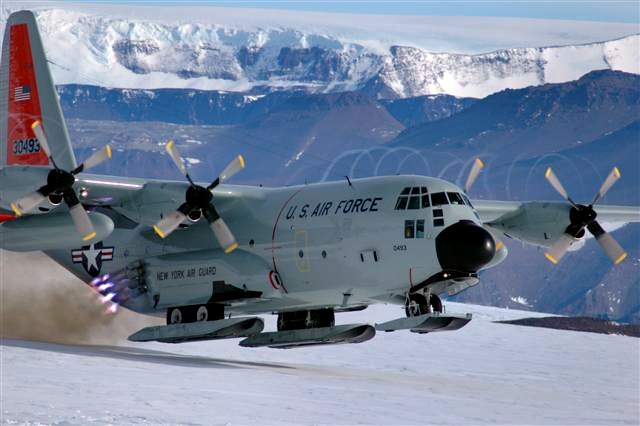|
LC-130 upgradesNational Guard looks to improve 'skibird' efficiencies and operationsPosted August 22, 2008
It’s more than just a little bumpy for New York Air National Guard “The sheer roughness of the location was such that at times our crews could barely read the instrument panel,” said Lt. Col. George Alston, chief of aircrew training for the 109th Airlift Wing, based at the Stratton Air National Guard Base “Sometimes getting the plane off the snow is a huge challenge,” he added. The Guard, which flies the ski-equipped Lockheed C-130 Hercules for missions around the continent on behalf of the U.S. Antarctic Program (USAP) One proposed improvement may take to the Antarctic skies this upcoming field season, with one of the “skibirds” sporting eight-bladed propellers versus the standard four-props the Hercs currently use. “It’s a great feature that we’re testing out and checking its viability,” Alston said. The 418th Flight Test Squadron (FLTS) “The main purpose of replacing the propellers is to see if we can increase the C-130’s take-off performance,” said Donna Knighton, 418th FLTS performance and flying qualities engineer, in a press release from Edwards Air Force Base earlier this year. The new propeller should provide more thrust at lower air speeds, helping lift the aircraft off the ice, as well as increase the C-130’s climb rate and cruise speed, improve short-field performance and reduce noise and vibration. Compared to the current four-blade propellers, which are very heavy and rectangular, the NP-2000 propellers are lighter and more aerodynamically shaped. Hamilton Sundstrand made the NP-2000 propellers, while Rolls Royce provided the engine. “If it meets the claims, it’s going to be great. It’s going to do more for less,” Alston said. He estimated the new propellers could increase fuel efficiency by about 5 percent, as well as decrease maintenance time. “It breaks less.” Another project to help get the C-130s off the ground involves replacing the current stock of jet-assisted takeoff (JATO) rockets. Strapped to the back of the plane to provide extra lift during takeoff, the JATO bottles in use today date back to the 1950s, according to Alston. “We’re starting to run out of them,” he said. “We got some funding, and we’re trying to get more funding from Congress, to get the supply to where we need it, to continue to do the mission, especially as we look into the possibility of going more and more into the deep field.” Currently, the Guard primarily flies between the McMurdo Eventually, the National Science Foundation Brian Johnson, manager of Field Science Support Services for Raytheon Polar Services, the prime contractor for the USAP, said the LC-130s this season will fly to remote camps at WAIS Divide The skibirds will also deliver materials, including helicopters, for an upcoming project near Pine Island Glacier in West Antarctica, one of the fastest moving glaciers on the continent. “In out years, West Antarctic will continue to be a focal point for science, but I am not sure to what extent,” Johnson said. “Unfortunately, with the recent budget constraints, we are still in the project review phases to fully understand the extent of LC-130 use in future seasons.” For the last four years, the Guard has flown an average of about 500 completed missions, according to Alston. This coming season that number should drop to about 300. When they happen, flights to the deep field, where groomed ice runways don’t exist, remain a risky venture. In November 1998, for instance, a C-130 broke through the surface of a bridged crevasse when it taxied for takeoff, sinking down to its wings. No one was injured, and the aircraft was later recovered. “If we want to go to deep-field sites right now, it’s a somewhat cumbersome process,” Alston said. New field sites require upwards of a year for evaluation. Smaller ski-equipped Twin Otter planes will often land at a site first, transporting a snowmobile with crevasse-detection radar. A new and compact crevasse-detection radar under development would allow the Guard to transfer the radar system between planes. A C-130 could survey a landing zone and set down on the snow all in the same flight, according to Alston. “It is a huge leap in capability,” he said. Johnson said he expects the USAP will be eager to use the new technology once it’s tested and ready for use. “This will allow for a quicker and less logistically challenging means to ‘prove’ a new landing area for the larger aircraft,” he said. All of these initiatives should happen in the next few years, Alston said. “All three of these are things we need sooner rather than later. They all not only improve capability, but they provide economic savings and improve safety margins, too.” |



For USAP Participants |
For The Public |
For Researchers and EducatorsContact UsU.S. National Science FoundationOffice of Polar Programs Geosciences Directorate 2415 Eisenhower Avenue, Suite W7100 Alexandria, VA 22314 Sign up for the NSF Office of Polar Programs newsletter and events. Feedback Form |



